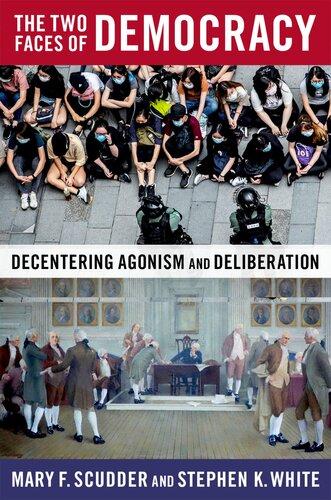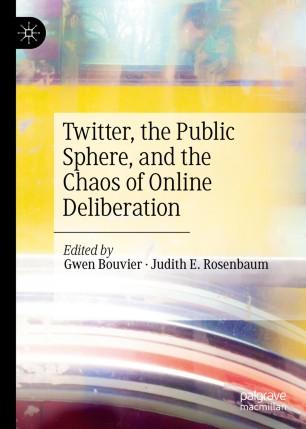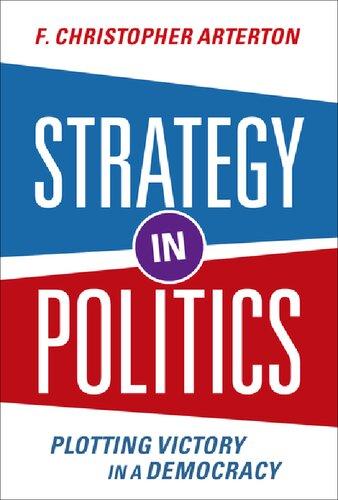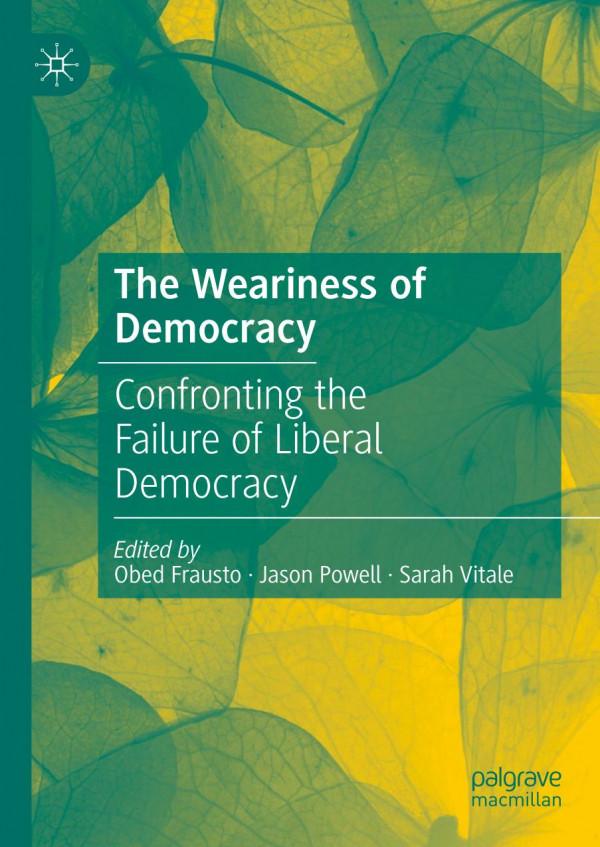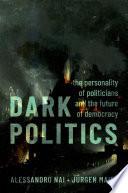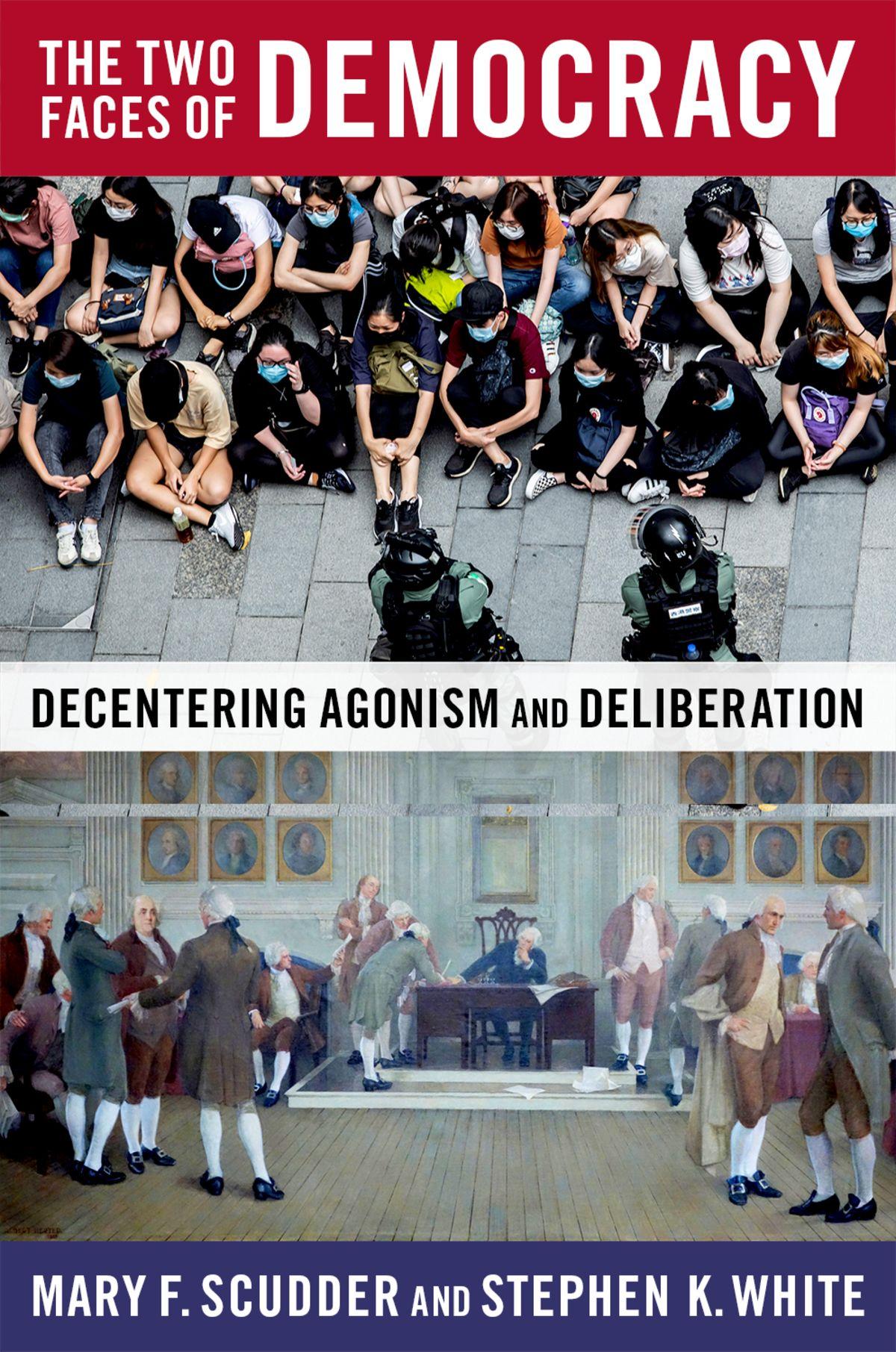The Two Faces of Democracy
Decentering Agonism andDeliberation
MARY F. SCUDDER AND
STEPHEN K. WHITE
Oxford University Press is a department of the University of Oxford. It furthers the University’s objective of excellence in research, scholarship, and education by publishing worldwide. Oxford is a registered trade mark of Oxford University Press in the UK and certain other countries.
Published in the United States of America by Oxford University Press 198 Madison Avenue, New York, NY 10016, United States of America.
© Oxford University Press 2023
All rights reserved. No part of this publication may be reproduced, stored in a retrieval system, or transmitted, in any form or by any means, without the prior permission in writing of Oxford University Press, or as expressly permitted by law, by license, or under terms agreed with the appropriate reproduction rights organization. Inquiries concerning reproduction outside the scope of the above should be sent to the Rights Department, Oxford University Press, at the address above.
You must not circulate this work in any other form and you must impose this same condition on any acquirer.
Library of Congress Control Number: 2022058614
ISBN 978–0–19–762389–3 (pbk.)
ISBN 978–0–19–762388–6 (hbk.)
ISBN 978–0–19–762391–6 (epub)
DOI: 10.1093/oso/9780197623886.001.0001
Stephendedicatesthisbooktohisgrandson,
JonesKiefferDunay
Acknowledgments
Introduction: The Challenge of Imagining Democracy Today
The Deliberative Turn and U-Turn in Democratic Theory
The Deliberative Face
The Agonistic Face
Re-envisioning the Core of Democracy
An Exemplary Scene of the Moral Equality of Voice
Conclusion: The Communicative Model of Democracy
Bibliography
Index
ACKNOWLEDGMENTS
Stephen and I began work on this book in the Summer of 2020. At the time, we each were working on papers independently, exchanging them with each other for comments. My paper sought to defend the normative core of deliberative democracy while acknowledging the limitations of deliberativists’ responses to compelling critiques. Stephen was investigating how the clearly valuable democratic insights carried by some variants of agonism have been subtly undermined by certain framings of that tradition. Taking a step back, we realized that both of our papers pointed to the need for a fuller understanding of what we call the “two faces of democracy.” By joining together we intended to articulate how to best comprehend those two faces and explain why we feel the persistent, intuitive force of each. We hope this book achieves these goals.
In those early days of the project, I was emailing Stephen from the road. After months of isolation due to the COVID-19 pandemic, Kyle, Lola (eighteen months old), and I set out on a contactless road trip from Indiana to California. Once we arrived in Sonoma, we formed a pod and childcare co-op with my sister, her family, and my parents. Without their help, especially that of my mom and dad, John and Judy Scudder, I would not have had the time or energy to begin working on this project. I am so grateful for the love and assistance they provided my family and me. I also want to acknowledge the care shown to us by Bonnie and Tim Haynes whose willingness to drive thirteen hours for a visit never ceases to amaze me.
My colleagues and friends at Purdue have improved my ideas as much as my day-to-day life. A special thanks to Tara Grillos for the sustained friendship and speedy advice she has provided me these
past years. I am indebted to my mentors Rosie Clawson and Nadia Brown, two Academic Moms who have worked tirelessly to make our department and our discipline more diverse and inclusive. I am lucky to have them as role models and mentors. I am also thankful to have Valeria Sinclair-Chapman as a colleague and friend. In many ways, she embodies the two faces of democracy, always seeming to know when to resist and when to cooperate to achieve shared goals. I am grateful to my comrade-in-writing, Ann Clark, for talking me through the highs and lows of the academic writing process. Jimena Cosso and Macarena Guerrero, as well as their respective partners, my colleagues, Giancarlo Visconti and Reed Kurtz, have been great cheerleaders as I tried to write with a new baby in a pandemic. I am grateful to have them and their families in my life.
I presented some of the material in the book at the University of Virginia’s Political Theory Colloquium in November 2020. I thank the participants and my discussant, Ferdinand Flagstad, for their comments and suggestions. I also want to thank Michael MacKenzie and Patricia Boling for feedback they provided on earlier drafts of portions of this manuscript. I appreciate the permission to reprint material previously published in Mary F. Scudder, “Deliberative Democracy, More Than Deliberation,” Political Studies, Online First, pp. 1–18, https://doi.org/10.1177/00323217211032624.
I cannot imagine a better coauthor than Stephen. He was nothing but supportive and understanding when chapters got held up on my desk, including for the length of my parental leave in 2021. From the energizing Zoom meetings to the constructive conversations via track changes, writing this book with him has been a joy.
Finally, I would like to thank Kyle Haynes for his partnership. I am not exaggerating when I say that I could not have survived having two children on the tenure track if it were not for him (and his coffee). He never doubted me for a second, and it made a world of difference. Finding the time for me to work on this book was often a team effort. Lola, too, was a great help in this regard. Her curiosity and enthusiasm are contagious and her love for her baby brother convenient. For my part, I dedicate the book to my son Jack Scudder-Haynes who was born during its writing. Jack seems intent
on making me a morning person and deserves credit for his persistence.
—Mary F. (Molly) Scudder
I presented some of the material in the book at the Political Theory Colloquium, University of Virginia, September 2020 and at the Institute for Advanced Studies in Culture, September 2021. I thank the participants for their many insights.
I appreciate the permission of the following publishers to reprint material previously published: Sage Publications for reprinting portions of Chapter 4 from Stephen K. White, “Agonism, Democracy, and the Moral Equality of Voice,” Political Theory 50, no. 1 (Feb. 2022): 59–85; and the Institute for Advanced Studies in Culture for reprinting portions of “A Democratic Mythic?,” TheHedgehogReview 24, no. 1 (Spring 2022).
Thanks to the following individuals who read and offered helpful critical insights on some portion of the manuscript: Lawrie Balfour, Kevin Duong, Rita Felski, Jill Frank, Bonnie Honig, George Klosko, Brittany Leach, Lori Marso, Isaac Reed, Shalini Satkunanandan, William Scheuerman, Jay Tolson, Rachel Wahl, and Robert Wylie. I would especially like to thank those who provided more sustained commentary on the project as a whole: Murad Idris, Tae-Yeoun Keum, and Jaeyoon Park. Also, my appreciation goes to my coauthor, Molly, who has been the ideal partner in this intellectual adventure.
We would both like to thank the two anonymous reviewers for Oxford University Press and our highly skilled editors at the press, Angela Chnapko and Alexcee Bechthold, who made the whole process a pleasure.
Finally, I thank Pat for all her copyediting expertise, but even more for being as wonderful a life companion as one could imagine.
—Stephen K. White
The Challenge ofImagining Democracy Today
When we think about classic moments we associate with democracy, one or the other of two sorts of pictures usually comes to mind. One is of public scenes where people are speaking, listening, debating, arguing, voting. Vivid, classical instances include the agora in ancient Athens, where democracy was born; scenes of town hall meetings in colonial New England and televised “town hall” meetings today; or the Constitutional Convention in Philadelphia in 1787. The other sort of classic moment involves scenes of protest and resistance against injustices perpetrated by tyrants or elites. Here we think of the Tennis Court Oath at the beginning of the French Revolution, where members of the Third Estate vowed not to be cowed by the king’s efforts to shut down their meetings; the resistance that came to be known as the Boston Tea Party or the Minutemen at Lexington and Concord before the American Revolution; or the street demonstrations against authoritarian rule in Egypt’s Tahrir Square in 2011 or during the “umbrella protest” in Hong Kong in 2014.
We might call these two portrayals of democratic life the two faces of democracy. Although they present to us somewhat different qualities, each captures essential intuitions about that political form, and both are assumed to represent core ideals. The first face portrays ideas of popular discussion, deliberation, and other activities central to the life of a legitimate democratic order. The second speaks to us about the necessity of oppositional protest against efforts to hold back or undermine democratic political
arrangements, including protests that claim a legitimacy even when they turn violent, as in the case of colonists’ actions leading up to the Declaration of Independence.
In referring to the two faces of democracy, we don’t mean two faces in the sense of the visages of two different people. Rather we mean the different “faces” a single person may display at different times; as when we say that a person’s face now shows anger but later curiosity. In the case of a single actor, we would normally be interested to know how the interaction between her character and her circumstances might have given rise to a face that expressed anger and then why it shifted to curiosity. Similarly, in the case of a democratic society, we are interested in providing an account of why a given set of circumstances should elicit activities that express one face more than another.
We certainly affirm that the two faces are tied together through their relation to comprehensive democratic intuitions and values, but we are concerned that the character of that connection and its underlying moral infrastructure are poorly understood. This lack of clarity has become more evident and unsettling recently, both in the world of real politics and in the efforts of scholars to conceptualize democracy.
One reason for a sense of distress is that in contemporary politics the face associated with classic instances of vehement democratic resistance has been repeatedly coopted by movements on the political right to advance ideas of white nationalism and other disturbing political orientations in ways that corrode democratic processes and the rule of law. In the last decade, right-wing, populist groups appropriated the images and names of the Boston Tea Party and the Minutemen. This process continued in the broader movement associated with the rise of Donald Trump.1 The American revolutionary flag picturing a snake coiled to strike against the boot of tyranny has also become a popular vanity license plate for this movement in a number of states. For many in these movements, and the armed, self-styled “militias” that have metastasized in recent decades, President Obama and the federal government became the
agents of tyranny, against whom righteous resistance was directed. And that flag was flown proudly by the Trump supporters as they stormed the U.S. Capitol in an attempt to prevent the transition of power mandated by the 2020 presidential election. In short, the classic call to political resistance against supposed threats to democracy has become increasingly associated with unprecedented violations of deep democratic norms. Thus, one sort of pictorial representation of democracy has become joined, on the right, with activities that are decidedly undemocratic, if not proto-fascistic.
Unsurprisingly, there have been vigorous, recent efforts across the political spectrum to push back against violations of basic democratic norms. These have occurred in the streets, the popular media, and academic publications. As one would expect, this upwelling has been most prevalent in the broadly defined political left in the United States. Concerns there accumulated into a flood of active and sometimes violent resistance in the wake of the police killing of George Floyd in May of 2020. As an illustration of such push back in the media, consider a 2019 article in the New Republic, under the title “Give War a Chance.” Alex Pareene speaks there of the growing number of voices within the Democratic Party who have become convinced of the need to meet the right’s “muscular and coherent ‘antagonistic’ approach to politics” with a comparable one on the left that unapologetically divides the world into political friends and enemies and urges us toward battle, as opposed to a more traditional orientation toward respectful engagement and mutual compromise.2 In relation to the two faces of democracy, the affective force behind Pareene’s essay draws us to determinately plant in the foreground the image of vehement and courageous resistance to those who threaten the basic norms of democracy, while backgrounding the picture of reason, deliberation, and compromise across lines of political difference. The left and center simply need to “give war a chance.”
If this distinctive foregrounding of one face of democracy is relatively recent in practical politics in the U.S., its contemporary intellectual roots extend somewhat further back. Pareene refers to
these when he mentions the growing influence of a Belgian political theorist, Chantal Mouffe. Since the early 1990s, Mouffe has become increasingly prominent (along with her now-deceased coauthor, Ernesto Laclau) in several European countries as well as the U.S.3 This elevation is based on her consistently arguing that conflict and resistance constitute the essential character—the ontology—of all political life, an account that has come to be called “agonistic.” The term “agonism” comes from the ancient Greek word, “agon,” meaning conflict or contest.4 Mouffe is hardly alone in embracing this orientation; she is part of a broader movement that has been gaining strength among political thinkers for some time.
This intellectual shift toward agonism emerged at least partially in reaction to the work of two of the most prominent political theorists of the late twentieth century, John Rawls and Jürgen Habermas. Rawls and Habermas came to be perceived as too tied to the assumption that Western political orders were tolerably just, and that the main job for political theory was to conceptually reconstruct the foundations of that democratic legitimacy. This orientation was apparent in Rawls’s immensely influential theory of justice and Habermas’s account of deliberative democracy.5 For the critics, these approaches offered idealized versions of liberal democratic orders grounded in reason, deliberation, and consensus about just political arrangements. Such works seemed to imply that any extant injustices in such regimes were secondary matters to be subsequently recognized and critically addressed on the basis of these constructs. In effect, they decidedly foregrounded one face of democracy: the one focused on reason, procedures, and debate.
Criticism of that broad intellectual strategy gathered momentum through the 1990s and has taken a multitude of forms. Perhaps the most significant commonality shared by these attacks on what has come to be called “ideal theory” is the charge that it inevitably tends to render secondary what should be primary. Such theory subtly slides concerns about persisting forms of domination and injustice into the background, thus providing an inflated sense of legitimation to the status quo.
This backgrounding, even if unintentional, runs the risk of giving ideological cover to those harms, making them appear less pressing. One of the first entrants onto this terrain of battle was Judith Shklar’s 1990 TheFacesofInjusticein which she argued for a global reorientation of attention in political theory: we should start political reflection from the patent reality of concrete instances of injustice and the struggles against it, and not from hypothetical, complex constructions of justice such as those of Rawls.6
Similar sentiments were expressed by many who began to style themselves as “realists” and attack “ideal theory.”7 Despite its popularity in recent years, what this movement substantively affirms has never become quite as coherent as the character of its attacks. After one has deflated the idealists, the actual normative direction in which one should go has remained somewhat amorphous. Perhaps this is one reason that the “agonist” version of realism has become so popular: it seems to have a clearer shape and more vivid character than the general calls to be more “realistic.”
“Agonism,” at least in its most emphatic form, is a specific variant of realism that proffers not only the idea that we should pay more attention to the conflictual elements of political life but also the specific claim that the concept of politics itself is constituted by the struggle of “friends” and “enemies.” And, proponents argue, the sooner we acknowledge this reality, the better. This call has achieved substantial resonance. As the editors of the American Political Science Association journal, Perspectives on Politics, declared in 2019, we “inevitably” face an “agonistic conception of the political.”8 Moreover, as others contend, this should not disturb us because it is now “uncontroversial” that agonism is a “democratic good.”9
In sum, we are in an era in which one face of democracy has, for many, increasingly receded into the background of public consciousness, while the other has moved into the foreground. Now, on one level, this is part of an expectable ebb and flow of democratic life; at any given time, one face will seem more relevant and appropriately prominent than the other. But, on a second level of reflection, there may be grounds for not being entirely
comfortable with the present state of affairs. As we have indicated, the current shift toward the face of conflict and resistance has been accompanied on the political right with a deeply disturbing slide toward actions that undermine basic democratic norms. And many of those involved in this slide seem to have placed themselves, even if only tacitly, on a path of self-justification that affirms potential democratic losses so long as they allow for the subduing of those who are now defined as their enemies.10
This phenomenon raises a challenge for all those committed to democracy. Clearly, there must be protracted contestation of this antidemocratic onslaught from the right. As citizens and academics, we wholeheartedly affirm this stance of resistance. But we also think it is wise to consider an intimately related question: Could there be some danger in this fight that our warranted contestation might also begin to corrode commitments to democratic norms? For some on the political right, resentment and self-righteousness are so intertwined with perceptions of warfare that they seem to miss the danger of such corrosion. Should combatants on the center and left feel immaculately immune from a comparable toxic amalgam of ideas and affects?
There have certainly been sobering examples in the past of leftist groups, like the Red Army Faction in Germany and the Weather Underground in the U.S. in the 1970s, who espoused the necessity of exterminating their enemies in democratic societies. Fortunately, there are few such movements now on the left. And with the electoral defeat of Trump in 2020, it could be that the immediate danger on the right will recede somewhat in the U.S., if not in other democratic countries such as Hungary. Little is certain at this point. Perhaps this juncture in the career of virulent forms of agonism provides us with a timely opportunity to reflect more carefully on the implicit pull of its corrosive framing of political life, without at the same time inordinately downgrading the enduring significance of the second face of democratic life with its portrayal of contestation and resistance.
But even if this sort of global practical relevance of our project seems apt, these concerns may still appear to be relatively academic and remote from grassroots-level politics. For a given group of protesters in the streets or a community organization resisting some palpable injustice, any mandate of attunement to both faces of democracy may understandably seem to be a remote matter of concern only to intellectuals. Only the agonistic face will be immediately relevant. In relation to questions of immediate strategy, this may be entirely correct. But if, in such cases, we expand the time frame or scope of actors involved, then the issues revolving around the other face will likely begin to seep into the relevant problem space. For example, questions about internal group structure and strategy may need to be extensively debated, as well as ones about the character of relations with other groups affirming somewhat different priorities. In these contexts, appeals that have recourse to normative criteria associated with the first face will likely surface. And if that expansion of concerns is actively precluded, it is probably an indicator that the group is trying to freeze out a kind of questioning intrinsic to a healthy democracy.
In short, there are ample practical reasons to inquire into the relation between the two faces. But the task of moving from this simple declaration to a lucid explanation of the connectedness of the two faces within the democratic imagination is no simple matter. Our book undertakes this task by trying to make clearer and more compelling the grounds upon which the two pictures, as well as the intuitions they embody, are interrelated. This requires a better theorization of the core normative commitments of democracy. We might think of this knot of commitments as functioning something like the role of character in understanding why a given individual’s face shows anger in certain circumstances but shifts to curiosity as those circumstances change; only here we will be trying to sketch what one might call the character of an admirable democratic political actor.
Toward that end we begin by exploring the two perspectives that offer the best insights into each face. For the face of conflict and contestation, we consider the agonistic turn in democratic theory,
looking for the most persuasive formulations that have emerged. For the face of reason and debate, we consider the tradition of deliberative democracy, looking for a version that could offer openings to the insights of agonism. Our ultimate aim is to articulate a distinct account of democracy, from the perspective of which one can assess the character, strengths, and limitations of both perspectives, revising each as necessary in order to illuminate how they might be persuasively imagined as existing in a relationship characterized by both tension and congruence.
Any effort to bring these two perspectives into alignment will likely have to confront the criticism that one or the other is subtly being accorded priority. This strikes us as a useful sort of initial suspicion of any attempt to do justice to both. In our case, many will suspect that the deliberative model is being assigned an initial privilege. And, in a way, it is. But the real test of whether our effort is successful is not where it starts, but whether our partially deliberative starting point can be integrated ultimately into a convincing way of comprehending the two pictures of democracy and the sorts of intuitions and values implied by both. That is what we hope to achieve by the end of the book.
For some, a figure prominent at our starting point will be maximally suspicious: Jürgen Habermas. After all, his account of deliberation, according to critics, is one of the primary poster children for one-sided accounts of democracy. Although there is some truth in this claim, there is just as much in the way of distortion. What we will offer is a partial borrowing from, but also a distinct revision of, what is at the core of his thought. Conceptually, we start from his theory of “communicative action,” rather than his specific idea of deliberation, with the intention of showing how the latter needs to be seen as derivative from a broader conception of normativity and interaction. Ultimately, this approach to democracy might be better called “communicative” than “deliberative” because it is oriented around the implicit norms that circulate in the linguistic intersubjectivity through which modern social life is symbolically reproduced. Iris Marion Young tried to signal her distance from the deliberative model by announcing a preference for the term
“communicative democracy.”11 She was an early admirer of Habermas’s approach to communicative action generally, as it emerged out of the central concerns of the Frankfurt School, but she was also consistently critical of the way the term “deliberative democracy” threatened to reduce our scope of critical vision. We share her sentiments, as well as her terminological preference. And, following that general tack, we aim to further develop a basis for conceptualizing democracy that decenters both the deliberative perspective and the agonistic one, with its greater focus on contestation and resistance.
When the term “deliberative democracy” is used today it refers to a broad movement in recent decades to center one’s assessment of democracy more precisely on the quality of the processes through which individuals come to discuss, debate, and mutually justify their respective stances before voting or taking other sorts of political action. Perhaps the most famous encapsulation of this slant is the general idea that the discursive means by which a majority becomes a majority in a democracy is just as important as the fact that a majority has voted in one way or the other.12 The movement to give such concerns a guiding role in our thinking about democracy has, over the last three decades, become a full-scale research tradition in the sense of encompassing a multitude of publications, research groups, and practical experiments designed to enhance deliberation about significant public issues, both in the U.S. and around the world. But, as we indicated above, this movement has also spawned an enormous amount of opposition that generally accuses it of emphasizing too heavily only what we have called the first face of democracy and thereby obfuscating how power operates inconspicuously to keep various issues and groups out of forums of deliberation. In short, deliberative democrats systematically draw our attention away from the connotations, affects, and motivations associated with the second face of democratic life.
As noted earlier, the agonistic turn in democratic theory emerged partially out of this context of critique and partially out of a general feeling that leading liberal democracies today should not be
accorded the benefit of the doubt in being identified as moderately just, given persisting racial and ethnic injustices, as well as the rapid growth of economic inequality since the late 1970s. Perspectives on justice and democracy that do not front-load such concerns need to be replaced by ones that make conflict and resistance to elites the starting point and center of attention. Agonism has been fleshed out in a variety of ways, but they all share this general motivation to accord an emphatic prominence to the resistant face of democracy. Despite the warranted sense of achievement that is shared by proponents of this new prominence, the question that emerges with this reversal of status between the two faces is whether we now get any better comprehension of therelationshipbetween them than we did when the first face was given unquestioned prominence.13 The goal of this book is to provide a persuasive answer to this question in a way that grants one-sided prominence to neither but sees both as intertwined with a common normative core; our preference for the term “communicative democracy” is intended to highlight this reorientation.
As we pursue this goal, it is important to emphasize that the role we envision for our efforts is not reducible to that of a peace negotiator who strives simply to bring two antagonists to some negotiated end of hostilities. Others have chosen that strategy, seeking to find a way to have these opponents simply “converge in the middle sharing similar values.”14 In contrast, we attempt to articulate an independent, constructive perspective on democracy and its moral core that provides a distinctive viewpoint, from the perspective of which one can then relocate the significance of both the agonistic and deliberative approaches.
Chapter 2 begins with a broad attempt to construe the deliberative approach in such a way that it can be taken as the best representative of the first face of democracy, and thus the fittest contender among competing conceptions of democracy to take on the challenge of agonism. Accordingly, we will offer an account of the emergence of the deliberative perspective around 1990, as it appears in Habermas and others, consider its evolving shape over
time, and evaluate some of the ways it has responded to a variety of specific criticisms.
Two criticisms, however, stand out as especially challenging and thus worthy of separate and more sustained treatment. These are global assaults on the whole enterprise of the deliberative perspective, as opposed to the more specific criticisms examined in Chapter 2. The first of these broader critiques surveys the train of particular complaints against this perspective over the last couple decades and concludes that the best way forward is to simply abandon any emphasis on deliberation as the core concept animating the first face. The problem, these critics argue, is that the many efforts to save the deliberative perspective by expanding what can count as “deliberation” end up amounting to nothing more than “concept stretching.” In short, accumulating piecemeal modifications of the model have so expanded the notion of deliberation as to render it effectively useless.15 As a consequence, the idea of making deliberation the centerpiece of democratic theory should just be dropped. It makes better sense to simply return to an emphasis on some of the more familiar ideals traditionally associated with democracy, such as inclusion in agenda formation and decisionmaking.16
In Chapter 3, we argue instead that the real problem lies with those advocates of deliberative democracy who overly concentrate attention on practices of deliberation and fail to comprehend adequately the normative core that should animate this perspective as a whole. That core, properly conceived, orients our understanding of the deliberative model to its commitment to a complex, central value, themoralequalityofvoice. On our interpretation this provides a minimal conceptualization of both autonomy and equality. In regard to the latter, it offers a way of conceptualizing how individual autonomy necessarily opens into democratic autonomy. Chapter 3 focuses primarily on this last value, showing how understanding it within our frame helps deliberative democrats decenter the specific practice of deliberation. Deliberation can now be seen as one variant of communication among a variety of others, each of which may play
a role in enhancing democratic autonomy and equality. Accordingly, a range of modes of communication, including, for example, rhetorical expression, storytelling, and expressive protest, can be assessed not as watered-down variants of deliberation but in terms of their contribution to promoting or undermining the values of autonomy and equality in a given political order.
When understood in this sense, we suggest that the deliberative approach does not have to devolve into an increasingly amorphous conglomeration of insights lacking coherence. Rather, it deserves to be ranked as the best way to conceptualize the first face of democracy. At the same time, however, one can also see why it makes sense to begin referring to our conceptualization not as a deliberative but as a “communicative” model.
Still, our arguments up to this point are not sufficient to answer the second global challenge we identified above, namely, the one arising from agonism. The main charge here is not so much that the idea of deliberative democracy is conceptually useless; rather, that it ends up being ideologically biased. Our goal in Chapter 4 is not to demonstrate that this critique is wrong but to construe it in a fashion that allows agonism to take a crucial place in the democratic imagination, without it also exerting a corrosive force on other democratic values. The concern here is to carefully explore how any given take on agonism, which interprets the political world as essentially characterized by conflict, might be capable of negotiating its way from that stance to the affirmation of some normative infrastructure that can democratically constrain such conflict.
This concern about the potential danger of agonism is not merely imagined. Mouffe is the outstanding case in point. The reason is that she has grounded herself in the work of the twentieth-century German jurist and political thinker, Carl Schmitt, who quite clearly believed his agonism accorded well with Nazism. Our point in calling attention to this is not to score easy points against Mouffe but to argue that we must be extremely careful in how we construe the claims of agonism. Although Mouffe thinks she can free her version from the less attractive features of Schmitt’s thought, we have our doubts, and the difficulties we elaborate highlight a serious
challenge to any variant of agonism. What resources does agonism and its ontology of conflict have to ensure an adversarial orientation toward our enemies stays within democratic bounds? Fortunately, Mouffe is not the only game in town; there are other, better conceptualizations of this perspective that make insightful efforts to more persuasively imagine how we might construe the claims of agonism. Although such work takes us some of the way toward the sort of capacious perspective that is needed, we nevertheless conclude that it does not offer a fully convincing path to understanding the tensional congruence that should characterize the relation between the two faces of democracy. The central problem revolves around equality and autonomy. An appeal to these values is clearly central to these agonists’ concerns about domination and injustice, but, as we show, they have not presented adequate conceptualizations of them.
Thus, just as Chapters 2 and 3 show the faults of deliberative theory, Chapter 4 does the same for agonism. Having developed these critiques, our overall goal then is to articulate an account of the moral core of democracy that is capacious enough to incorporate the valid insights of both perspectives and yet avoid their shortcomings. If this can be done persuasively, it will allow one to see how the two faces of democracy are interrelated. Progress toward that goal requires two steps. First, in Chapter 5, we clarify and defend what it might mean today to speak generally of a moral core or ‘foundational’ account of politics in what one of us has called elsewhere a “weak-ontological” sense.17 Such a core needs to be elucidated in the form of what we call an “originary exemplary scene.”18 A significant part of the task of unpacking this notion involves explaining how its persuasiveness depends not just on its appeal to our reason but also to our imagination; in short, the protonarrative it relates has to engage us with affective force. One of the key tasks of that chapter, as well as the following one, is to make clear what this implies. A prominent concern that emerges when an appeal to the imagination is allowed such an enhanced role in political thinking is that it would seem to entangle the moral core of
politics in a relationship with myth. For many, any involvement of myth with democratic thinking carries significant danger. Hence, our turn onto this terrain will need to proceed carefully.
After elucidating, in Chapter 5, the general criteria that a broadly acceptable idea of ‘foundations’ must satisfy today, we turn in Chapter 6 to the second step: an elucidation of the specific moral core of our communicative model of democracy, and how it is portrayed as an originary scene that embodies the central value of moral equality of voice. We unpack the notion of equality and show why, in our framework, it must be conceived not as a stand-alone value but as one embedded within the dynamics of an originary scene and constitutively related to democratic autonomy. Although this idea of orienting a democratic citizen’s imagination around such a generative scene might sound unfamiliar, even jarring, in the present context, that initial reaction might be lessened by considering how often in the history of political thought appeals have been made to generative “scenes” of some sort. Consider the role of the venerable notion of the “state of nature” in social contract theory or of the more contemporary idea of the “original position” in Rawls. Although our notion shares with these kinds of scenes a sort of primary status, the exemplary scene we have in mind differs quite significantly from them. It is not tied to a sense of strong ontology with God at the center, as is Locke’s scene, nor is it a sketch of what a generic rational actor would choose, as is the case with Rawls’s scene (at least in its initial form). Our exemplary scene’s role is to orient our reflection and imagination in relation to how communicative interactions open themselves to our most basic democratic intuitions and perceptions. Such a scene helps make vivid to us both how we should react to the social dynamics in which we are embedded and why we modern democrats find the two faces so consistently moving: they embody our basic intuitions about democratic life. Moreover, the originary exemplary scene developed here specifically enhances our ability to see the appropriateness of a shift from one picture to the other, not just as an occasional, onedimensional reaction to a given set of political events but also as
reflecting a judgment that cogently expresses a fuller democratic citizen bearing.
If our efforts in this book are successful, we will have helped make it a little easier to see the place and appropriateness of both faces of a healthy democratic body politic that is continually in the process of rethinking itself. What exactly do we mean by this claim and why is it important? Consider a recurrent tension in American politics between vehement protest in the name of redressing grievances about deep-seated injustices, on the one hand, and vehement objections to that in the name defending normal democratic arrangements of “law and order,” on the other hand. This tension has played out multiple times in recent American history. One way of describing it is as a dispute over which face of democracy should be prioritized. Among some Americans in recent decades, protest and resistance have often been met with insistent demands that politics show more “civility.” Accordingly, in times of such turmoil in the streets, a venerable and reliable strategy for some political leaders has been to righteously demand the restoration of law and order. President Richard Nixon was a master at making this sort of appeal to the “silent majority” who saw protest as essentially “unAmerican.” He banked on the propensity of many white Americans to affirm only the first face of democratic politics and vote for him based on that commitment.
In mid-2020, President Trump returned to this playbook in as cynical a way as one could imagine, attempting to rally white Americans to affirm his condemnation of the huge wave of protest emerging out of outrage at police killings of George Floyd and other African Americans. Clearly, Trump found some resonance for his demands for law and order. But there is also evidence that increasing numbers of Americans showed themselves more resistant to such appeals than in the past. Polls in states where some of the killings occurred and where large, sometimes violent, protests followed indicated that Trump’s simple calls to law and order were relatively ineffective.19 We would contend that this is evidence that perhaps there is an incipient learning process going on here, in
which growing numbers of people are coming to better understand that democracy has not one, but two, faces, and that especially in societies with deep and persisting injustices, actions expressing the second face are as much a part of democratic life as actions expressing the first. Our aim in this book is to bring the modest tools of political theory to bear, helping people see more clearly the stakes of this controversy and thus perhaps to contribute in a small way to this slow, but hopefully ongoing, process of civic education. The appearance of such positive signs should never be construed, however, as simple markers of irreversible progress; significant forces always push against such Whiggish expectations. The communicative model of democracy we articulate here aims to embody such a complex awareness.
1. For an analysis of this phenomenon, see Stephen K. White, A Democratic Bearing: Admirable Citizens, Uneven Injustice, and Critical Theory (Cambridge: Cambridge University Press, 2017), Ch. 2.
2. Alex Pareene, “Give War a Chance: In Search of the Democratic Party’s Fighting Spirit,” The New Republic, June 20, 2019, https://newrepublic.com/article/154113/democratic-party-fighting-spirit-give-warchance.
3. See Chantal Mouffe, The Democratic Paradox (London and New York: Verso Books, 2000). Mouffe and Laclau, espousing agonism and populist “hegemony,” have been drawn upon by politicians (some of whom were their students) across the European continent; see Benjamin McKean, “Toward an Inclusive Populism? On the Role of Race and Difference in Laclau’s Politics,” Political Theory 44, no. 6 (Dec. 2016): 797–820.
4. The first deployment of the idea of agonism relevant to current usage is in Nietzsche’s “Homer’s Contest,” in On the Genealogy of Morals ed. Keith Ansell Pearson (Cambridge: Cambridge University Press, 1994), 187–194.
5. John Rawls, A Theory of Justice (Cambridge, MA: Harvard University Press, 1971); and Jürgen Habermas, Between Facts and Norms Between Facts and Norms: Contributions to a Discourse Theory of Law and Democracy, trans. William Rehg (Cambridge, MA: MIT Press, 1996).
6. Judith N. Shklar, The Faces of Injustice (New Haven and London: Yale University Press, 1990).
7. See, e.g., Raymond Geuss, Philosophy and Real Politics (Princeton: Princeton University Press, 2008); and Bernard Williams, In the Beginning Was the Deed:
Realism and Moralism in Political Argument, ed. with an introduction by Geoffrey Hawthorn (Princeton: Princeton University Press, 2005).
8. Daniel O’Neill and Michael Bernhard, “Perspectival Political Theory,” Perspectives on Politics 17, no. 4 (Dec. 2019): 953.
9. Lida Maxwell, introductory statement to the critical exchange, “The ‘Agonistic Turn’: Political Theory and the Displacement of Politics in New Contexts,” Contemporary PoliticalTheory 18, no. 4 (2019): 640.
10. This kind of logic could not have been more vividly displayed than in the multidimensional crescendo of Trump-supporter efforts to overturn the 2020 election results in the U.S. based on a willful denial of facts and confident sense that behavior that would normally be judged corrupt and insurrectionary was to be esteemed as heroic (by friends) and necessary to save the republic from mortal danger (at the hands of domestic enemies).
11. Iris Marion Young, Inclusion and Democracy (Oxford: Oxford University Press, 2000), 40.
12. Habermas, Between Facts andNorms, 304.
13. Ours is hardly the first effort to grapple with the question how to comprehend this relationship. Marie Paxton’s Agonistic Democracy: Rethinking Political Institutions in Pluralist Times (London and New York: Routledge, 2020) tends to take the good of agonism to be largely unproblematic and then works to show that we can negotiate a straightforward settlement with more traditional frameworks in political theory. This allows her to move on relatively effortlessly to her proposals to reform democratic institutions in a way that reflects this settlement. From our perspective she resolves the whole dispute between agonism and deliberation too quickly, without sufficiently probing the depth of the disagreement involved. See especially 1–22, 139–141.
Others take the dispute more seriously and look in more detail, as we do, at how one might better conceive the relationship between agonism and traditional approaches to democracy. Ed Wingenbach’s Institutionalizing Agonistic Democracy: Post-Foundationalism and Political Liberalism (London: Routledge, 2011) proposes a reconciliation of Mouffean agonism and Rawlsian political liberalism; see especially xv and Ch. 7. He argues that an “agonistic liberalism can emerge from Rawlsian premises” (159). We don’t find this marriage to be wellconceived on either end. Mouffe’s agonism is never subjected to sufficient critical analysis, and Wingenbach’s watering down of Rawls’s central ideas of “overlapping consensus” and a “well-ordered society” leaves the force of that perspective in a rather unclear state.
Another somewhat related attempt at negotiation is Steven Gormley, Deliberative Theory and Deconstruction: A Democratic Venture (Edinburgh: Edinburgh University Press, 2020). He tries to chart a course between deliberation and Derridean deconstruction that takes the insights of both seriously, develops criticisms of both, and sees an “overlap in their shared hope . . . in the promise of democracy to open up the possibility of doing justice to the other.” His admirable
effort has some slight parallels with ours, but, given that he is not taking on agonism per se but deconstruction, the project is not exactly the same. See 4–5, 190–192.
Finally, there is Arletta Norval’s excellent work, Aversive Democracy: Inheritance and Originality in the Democratic Tradition (Cambridge: Cambridge University Press, 2009). Although committed to the agonistic approach, she nevertheless perceptively highlights many of its shortcomings, turning to Wittgenstein and Cavell to remedy them, as well as critiques standard deliberative approaches. There is much to admire in this effort, but we would argue that she does not offer an adequate articulation of the key value of equality of voice. Moreover, we think that her criticisms of deliberative democracy, as well as her affirmation of aspects of Wittgenstein and Cavell, can be encompassed within our portrait of a “communicative model” of democracy.
14. Paxton, Agonistic Democracy, 139. Compare the similar strategy pursued in Wingenbach, Institutionalizing Agonistic Democracy, xv.
15. David Owen and Graham Smith, “Deliberation, Democracy, and the Systemic Turn,” JournalofPoliticalPhilosophy 23, no. 2 (2015): 213–234.
16. Mark E. Warren, “A Problem-Based Approach to Democratic Theory,” American PoliticalScience Review 111, no. 1 (2017): 39–53.
17. Stephen K. White, Sustaining Affirmation: The Strengths of Weak Ontology in PoliticalTheory (Princeton: Princeton University Press, 2001).
18. The idea of appealing to such a scene, is sketched in a preliminary (and rather flawed) way in White, A Democratic Bearing, 57–68. In Chapters 5 and 6, we will delineate the relation between such an originary scene and more particular scenes from history or literature, such as the two types we appealed to at the beginning of this chapter.
19. In states like Minnesota and Wisconsin, which suffered some of the most violent and disruptive protests in summer, 2020, Trump got little if any traction from such appeals and failed to win these in the ensuing election. See Alexander Burns and Jonathan Martin, “Trump Onslaught Against Biden Falls Short of a Breakthrough,” New York Times, September 12, 2020, https://www.nytimes.com/2020/09/12/us/politics/biden-trump-poll-wisconsinminnesota.html. Of course, many on the political right did affirm Trump’s law and order appeal, but in the weeks leading up to the 2020 election, a New York Times/Siena College poll, October 15–20, 2021, showed that, nationally, likely voters found that Joe Biden would “do a better job” in “maintaining law and order” than Donald Trump by a margin of 6 percentage points. See https://scri.siena.edu/2020/10/20/the-new-york-times-siena-college-national-pollbiden-leads-trump-50-41/.
The Deliberative Turn and U-Turn in Democratic Theory
The deliberative model of democracy has enjoyed relative dominance in the study of democratic theory since it emerged in the 1990s. It has blossomed into a full-blown research paradigm. The deliberative model’s prominence is especially visible when we consider how it has been adopted and developed by scholars studying democracy from an empirical perspective.1 Empirical studies of deliberative democracy aim to identify when and under what conditions political communication rises to the level of “democratic deliberation” and to understand the effects of that deliberation in practice.2 Does deliberation lead to pro-social behavior or other desirable outcomes?3 Who wants to deliberate and why?4 What are the barriers to achieving deliberation? And can deliberation help us make headway on intractable social or political issues both domestically and internationally?
Despite the prominence of this broad empirical research paradigm, intense debate over the normative value of deliberation and the deliberative model has continued. This chapter presents the deliberative approach to democratic politics as it originated in the work of Habermas and others. Of particular interest to us is the extent to which deliberative democratic theory has succeeded in doing justice to both faces of democracy. It might seem, given its emphasis on reasoned argumentation and consensus, that the deliberative model all but ignores the face of democracy dealing with resistance and contestation. And given how debates between deliberative and agonistic democrats evolved in the years after
democratic theory’s deliberative turn, it is easy to overlook the extent to which the deliberative model itself grew out of a sensitivity to difference and disagreement in democracy.
Going back to the earliest articulations of the model, however, we identify a general attempt to account for both faces of democracy. Through this discussion, we come to see this model as the best representation of the first face of democracy, and thus the fittest contender among competing conceptions of democracy to take on the challenge of agonism. Ultimately, however, while we argue that the deliberative model is crucial to our understanding of democracy amid deep difference, it is nevertheless still missing important normative components that would allow it to do full justice to both faces of democracy.
This chapter begins by tracing the emergence and development of the core claims of the deliberative idea of politics in the last three decades of the twentieth century (Section I). We analyze the earliest articulations of this idea, paying special attention to the common themes that unite them. Specifically, we consider the unique way that deliberative democracy conceives of (A) legitimacy, (B) procedure, and (C) disagreement. For deliberative democrats, legitimacy, especially in contexts of difference and disagreement, emanates from specific communication-based, decision-making procedures. Next, we consider the model’s evolving shape over time as it has tried to respond to a variety of criticisms from within and without. In Section II, we consider challenges to both the feasibility and desirability of the deliberative ideal in large complex plural societies, and we survey some ways that deliberativists have responded to these challenges. As we show, a key strategy for responding to these criticisms has been to expand the deliberative ideal so that it is not so focused on rational discourse, narrowly understood. In Section III we turn our attention to what has come to be called the systems approach to deliberative democracy. This approach emerged as a way to bring a more expansive view of deliberation in line with the deliberative ideal. We consider the extent to which this systemic turn was successful at offering a reliable path to democratic legitimacy in large complex societies.
